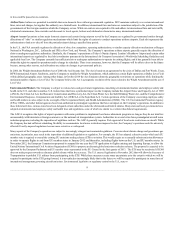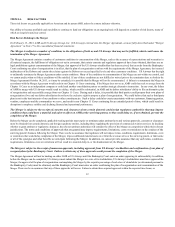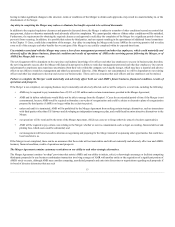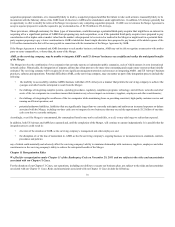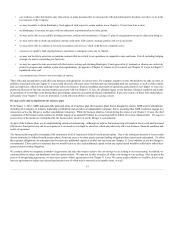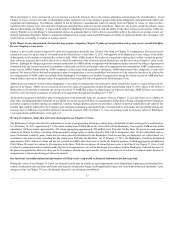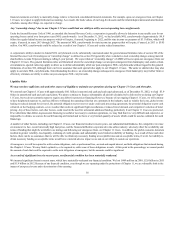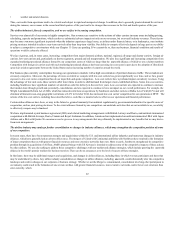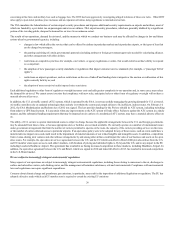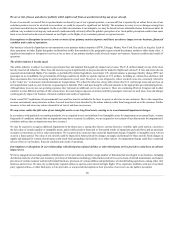American Airlines 2012 Annual Report Download - page 18
Download and view the complete annual report
Please find page 18 of the 2012 American Airlines annual report below. You can navigate through the pages in the report by either clicking on the pages listed below, or by using the keyword search tool below to find specific information within the annual report.
financial statements are likely to materially change relative to historical consolidated financial statements. For example, upon our emergence from our Chapter
11 Cases, we expect to apply fresh start accounting. As a result, the book values of our long-lived assets and the related depreciation and amortization
schedules, among other things, are expected to change.
Any “ownership change” due to our Chapter 11 Cases could limit our ability to utilize our net operating loss carryforwards.
Under the Internal Revenue Code of 1986, as amended (the Internal Revenue Code), a corporation is generally allowed a deduction in any taxable year for net
operating losses carried over from prior years (NOL carryforwards). As of December 31, 2012, we had available NOL carryforwards of approximately $6.8
billion for regular federal income tax purposes which will expire, if unused, beginning in 2022, and for state income tax purposes of $3.1 billion, which will
expire, if unused, in years 2013 through 2027. The amount of NOL carryforwards for state income tax purposes that will expire, if unused, in 2013 is $105
million. Our NOL carryforwards could be reduced as a result of our Chapter 11 Cases and certain related transactions.
A corporation's ability to deduct its federal NOL carryforwards can be substantially constrained under the general annual limitation rules of section 382 of the
Internal Revenue Code if it undergoes an “ownership change” as defined in section 382 (generally where cumulative stock ownership changes among material
shareholders exceeds 50 percent during a rolling 3-year period). We expect that an “ownership change” of AMR will occur upon our emergence from our
Chapter 11 Cases. The general limitation rules are liberalized where the ownership change occurs upon emergence from bankruptcy and, under certain
circumstances, special rules may apply to allow us to utilize substantially all of our post-emergence NOL carryforwards without regard to the general
limitations of section 382, although there can be no assurance that such special rules apply to our Chapter 11 Cases. The same or similar rules may also
apply to our state NOL carryforwards. Notwithstanding the above, an ownership change subsequent to emergence from bankruptcy may further limit or
effectively eliminate our ability to utilize our post-emergence NOL carryforwards.
Liquidity Risks
We may not have sufficient cash and other sources of liquidity to maintain our operations during our Chapter 11 Cases and thereafter.
We entered our Chapter 11 Cases with approximately $4.1 billion in unrestricted cash and cash equivalents and, as of December 31, 2012, we had $3.9
billion in unrestricted cash and cash equivalents. We plan to continue to finance substantially all aircraft scheduled to be delivered to us during our Chapter
11 Cases, but we do not currently expect to require any debtor-in-possession financing. However, because of our ongoing Chapter 11 Cases, we will continue
to have heightened exposure to, and less ability to withstand, the operating risks that are customary in the industry, such as volatile fuel costs, global events
leading to reduced demand for air travel, the potential obligation to post reserves under credit card processing agreements, the potential obligation to post cash
collateral on fuel hedging contracts, severe weather that results in significant flight cancellations or reduced travel demand, and competitors' reduction of ticket
pricing. Any of these factors, and other factors, could result in the need for substantial additional funding, particularly if our Chapter 11 Cases are protracted.
If we determine that debtor-in-possession financing is useful or necessary to continue operations, we may find that it is very difficult and expensive, or
impossible, to obtain, as sources for such financing are limited and we have a very limited quantity of assets which could be used as collateral for such
financings.
A number of other factors, including our Chapter 11 Cases, our financial results in recent years, our substantial indebtedness, the competitive revenue
environment we face, recent historically high fuel prices, and the financial difficulties experienced in the airline industry, adversely affect the availability and
terms of funding that might be available to us during, and following our emergence from, our Chapter 11 Cases. In addition, the global economic downturn
resulted in greater volatility, less liquidity, widening of credit spreads, and substantially more limited availability of funding. As a result of these and other
factors, there can be no assurances that we will be able to obtain any necessary funding at acceptable rates and on acceptable terms, if at all. An inability to
obtain necessary funding on acceptable terms would have a material adverse impact on us and on our ability to sustain our operations.
At emergence, we will be required to settle certain obligations, such as professional fees, accrued and unpaid interest, and debt obligations that matured during
the Chapter 11 Cases. We may find it optimal to, or be required to, settle some of these obligations in cash. At this point in the proceedings, we cannot predict
the amount of cash that could be required to settle such obligations at emergence, but the amounts could be significant.
As a result of significant losses in recent years, our financial condition has been materially weakened.
We incurred significant losses in recent years, which have materially weakened our financial condition. We lost $469 million in 2010, $2.0 billion in 2011
and $1.9 billion in 2012. Because of our financial condition, even though we are operating under the protections of Chapter 11, we are vulnerable both to the
impact of unexpected events and to deterioration of the operating
18


